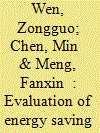| Srl | Item |
| 1 |
ID:
137702


|
|
|
|
|
| Summary/Abstract |
Much of China's cement industry still uses outdated kilns and other inefficient technologies, which are obstacles to improving energy efficiency. Huge improvements in energy consumption intensity can be made by improving this technology. To evaluate the potential for energy-saving and CO2 emissions reduction in China's cement industry between 2010 and 2020, a model was developed based on the Asian-Pacific Integrated Model (AIM). Three scenarios (S1, S2 and S3) were developed to describe future technology policy measures in relation to the development of the cement industry. Results show that scenario S3 would realize the potential for CO2 emissions mitigation of 361.0 million tons, accounting for 25.24% of the predicted emissions, with an additional energy saving potential of 39.0 million tons of coal equivalent by 2020. Technology promotion and industrial structure adjustment are the main measures that can lead to energy savings. Structural adjustment is the most important approach to reduce the CO2 emissions from the cement industry; the resulting potential for CO2 emissions reduction will be increasingly large, even exceeding 50% after 2016.
|
|
|
|
|
|
|
|
|
|
|
|
|
|
|
|
| 2 |
ID:
096743


|
|
|
|
|
| Publication |
2010.
|
| Summary/Abstract |
Electric utilities and regulators face difficult challenges evaluating new energy efficiency and smart grid programs prompted, in large part, by recent state and federal mandates and financial incentives. It is increasingly difficult to separate electricity use impacts of individual utility programs from the impacts of increasingly stringent appliance and building efficiency standards, increasing electricity prices, appliance manufacturer efficiency improvements, energy program interactions and other factors. This study reviews traditional approaches used to evaluate electric utility energy efficiency and smart-grid programs and presents an agent-based end-use modeling approach that resolves many of the shortcomings of traditional approaches. Data for a representative sample of utility customers in a Midwestern US utility are used to evaluate energy efficiency and smart grid program targets over a fifteen-year horizon. Model analysis indicates that a combination of the two least stringent efficiency and smart grid program scenarios provides peak hour reductions one-third greater than the most stringent smart grid program suggesting that reductions in peak demand requirements are more feasible when both efficiency and smart grid programs are considered together. Suggestions on transitioning from traditional end-use models to agent-based end-use models are provided.
|
|
|
|
|
|
|
|
|
|
|
|
|
|
|
|